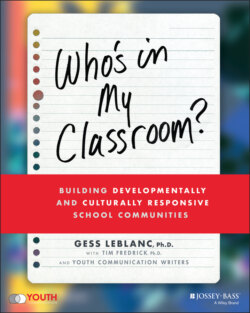Читать книгу Who's In My Classroom? - Tim Fredrick - Страница 13
Development Is Shaped by Multiple Settings
ОглавлениеAnother important way to think about how adolescents develop is to think about the different settings that influence development. My research is informed by the work of the late developmental psychologist Urie Bronfenbrenner. His well-regarded theory is that development is influenced by our individual characteristics (such as our age, gender, race, or ethnicity) and our experiences within multiple settings that influence us all at the same time.10 He describes these experiences as “proximal” or up-close influences (such as our experiences within our families or our experiences in school) and “distal” or more distant influences (such as the type of jobs our parents had). He argues that we are influenced by the interplay between them (such as when parents’ work schedules make them unavailable to assist their children with homework).
Drawing on Bronfenbrenner's work, I believe that supporting our students’ developmental needs means paying close attention to how these simultaneous influences shape their development. In the following excerpt, Hoa Vu reflects on how her father's abandonment and her mother's poverty impacted her social development and her relationships with her peers:
One night four years ago, while other children were enjoying the end of a lazy summer day, I was sitting on the sidewalk outside my apartment building with all my stuff. My mother often told me not to sit on the sidewalk, but tonight she didn't say anything. My brother sat on one of our suitcases with his head down. It was late. The city streets were quiet. We had been evicted.
It was a good thing no one was around because I hated the look people gave me when they felt sorry for me. The landlord gave me that look when he saw my brother and me packing up our childhood toys. The cops who told us that we were evicted gave us that look when they saw us place our suitcases on the sidewalk.
Every time we moved we got the look that became known to me as the look of pity. And we moved a lot. The first time was when I was around 7. That's about when my father left us. Until then, I had grown up in an apartment in Ridgewood, Queens, with both parents and my brother.
My mom used to work in telemarketing, but she stopped when my brother was born. After my father left, she didn't seem able to support us. My mother would convince a landlord to let us move in, but after we couldn't pay the rent for a few months, we would have to move to another place. This was a pattern that I considered normal. We moved so many times I didn't think it was strange.
For the next four years, I moved in and out of four shelters. My mother didn't do what the caseworkers told her to so we could get housing or even public assistance, which is one of the requirements to continue living in a shelter. Every time we moved, I had to start over with a new caseworker and try to explain my mother's refusal to talk to them, which I didn't understand myself. Eventually, they all gave up on us.
Living in shelters changed me. Almost from the first night, I started acting differently. I used to be the conversation starter, but not anymore. I grew quiet. I didn't want to make ties to people that I would have to cut when I moved again. Because I carried this logic with me I didn't make many friends.
As Bronfenbrenner suggests, the simultaneous influences of living with a single parent, living in poverty, and experiencing housing insecurity collectively shaped Hoa's view that having close relationships with her peers would be a liability. Instead, she believed that she could better protect herself and her emotions by not making friends. In school, she might appear as a “loner” or an “outsider” who might even seem to be socially withdrawn, socially awkward, and unable to make friends. In fact, it wasn't that she lacked the skill or desire to make friends. Rather, she “logically” decided that the cost of trying to make new friends, and the pain of losing them, would outweigh the benefits of those friendships.
